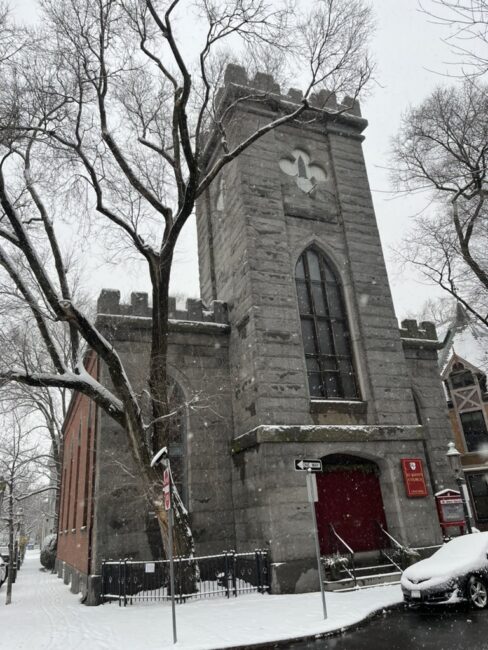Sermon — October 8, 2024
The Rev. Greg Johnston
Jesus’ words this week are hard for many people, for many different reasons. I don’t know how many of you listening right now have been divorced, and whether that was a good thing in your life or a hard one, or more likely, both. I don’t know how many of you are the children of parents who were divorced, or have seen your own children or siblings or friends go through divorce, and had those very different experiences of the disruption of family. I don’t know how many of you have known people who probably should be divorced, but aren’t, and have had to deal with that. I do know roughly how many of you grew up in church traditions that explicitly forbid divorce, and I suspect you’ve seen endure people abusive relationships as a result. Whatever the case may be, I don’t think it’s an easy topic for anyone—in a hundred different ways, Jesus’ words about divorce are hard to hear, and that’s because divorce is hard.
Sometimes it’s helpful to say a word about our own church’s position on things like this, for anyone listening who doesn’t know. Unsurprisingly, I think it’s a pretty good one. It’s actually enshrined in our church’s canon law that when someone comes to a member of the clergy because their marriage is in distress, the first duty of that priest is “to protect and promote the physical and emotional safety of those involved and only then… to labor that the parties may be reconciled.” (Constitution and Canons I.19.1) In cases of abuse or pain, physical or emotional, our first duty is to protect the person in front of us from harm. If and only if it’s safe for both people to remain in that marriage, then we try to honor their marriage vows by working toward reconciliation, trying to help repair that relationship. And yet sometimes, a marriage comes to an end; and yes, we will celebrate and bless second marriages after divorce. (And I’ll say for myself, as the child of two parents who divorced and later each re-married—I’m very glad that that’s the case.)
And this is, I hope you’ll agree, a reasonable and a nuanced attitude. There’s just one problem. Our attitude may be quite nuanced on this topic. But Jesus’ attitude? Maybe a bit less so.
So I want to take a second look at what Jesus has to say to us this morning, and I want to put in the context of three different things: in the context of the story itself, what’s happening in Jesus’ life when he says these words; in the context of first-century Judaism, the conversation that’s going on around Jesus relative to which he’s taking a position; and in the context of the whole long story of the Bible, the story of God and God’s creation. And then, if possible, we’ll bring it back to the present day.
So first: What’s happening in the Gospel when Jesus says these things? You might recall from a few weeks ago that Jesus is on the road from Galilee in the north, where he’s been teaching and healing, down toward Jerusalem in the south, where he’s predicted several times that he will suffer and die. He’s just arrived in Judea, the region around Jerusalem, and crowds have gathered again. We’ve arrived in the third quarter of Mark’s gospel: we had his ministry in Galilee and his journey to Judea; now his brief ministry in Judea, followed by his arrest, and trial, and death. The focus of the story has turned from Jesus’ life toward his death. And it’s now that “some Pharisees [come], and to test him they ask, ‘Is it lawful for a man to divorce his wife?’” (Mark 10:2)
It matters who’s asking the question, and when. It matters why they’re asking. This handful of Pharisees aren’t asking about divorce because they’re really curious, because they want to learn from Jesus. They’re not asking about a concrete case. They’re asking about the general rule, in the abstract, because they want to test him. They want to trip him up, to undermine him, to find some reason to accuse him of a gaffe. Jesus has a bit of a reputation for playing fast and loose with laws and customs ranging from what to do on the Sabbath to whether you’re required to ritually purify your hands before you eat. And others have tried to trip him up before, to make him look too liberal in a sense. But that’s not what Jesus does this time. He replies, “What does Moses say?” In other words, “What’s in the Torah? What’s in the Law?” (Mark 10:3) And when they answer—Moses allows a man to divorce his wife—Jesus doesn’t do what they expect. He doesn’t loosen the requirements of the law. He strengthens it, and their attempt to accuse him of abandoning the law God gave to Moses falls flat.
The Pharisees’ answer to Jesus’ question is right. Moses did “allow a man to write a certificate of dismissal and to divorce” his wife. (Mark 10:3) This isn’t an old-fashioned or gender-exclusive translation, by the way. The Torah allows a man to divorce his wife; not vice versa. We have historical evidence of a few women, aristocrats or wealthy merchants, who divorced their husbands; but these were cases of prominent women whose power allowed them to flaunt the Law, not follow it. The legal debate among religious scholars in Jesus’ day wasn’t about whether a man could divorce his wife, as the Pharisees asked—it was all about “when,” as in it was allowed. Rabbinic tradition records a disagreement, for example, between the “House of Shammai,” one of two rabbinic schools of thought, who taught that “a man should divorce his wife only” for reasons of “unchastity, since it is said,” and here they quote a verse from Deuteronomy, “‘Because he has found in her indecency in anything.’” But the House of Hillel, the other school, reply, “No,” he can divorce her “even if she spoiled his dish, since it is said, ‘Because he has found in her indecency in anything.’” (Mishnah Gittin 9:10) Infamously, a century later Rabbi Akiba would add: “Even if he found another more beautiful than she.” (This opinion did not win the debate, by the way.)
This is what Jesus means by “hardness of heart.” (Mark 10:5)
This was roughly the scope of the debate: analyzing the particular words from the Law of Moses that authorize divorce, and trying to parse out exactly the circumstances.
Jesus rejects that approach, in this case. He stops parsing the particular words of the law, and tries to put it in a much broader perspective. He re-tells the story of creation itself, the first moment of the first relationship between two human beings, that day in the Garden of Eden when God first says, “It is not good that Adam should be alone.” (Gen. 2:18) This is how things were before they ate the fruit. This is how things ere before the Fall. And this, Jesus says, is the way things ought to be. “Therefore those whom God has joined together let no one put asunder.”
Jesus is confronted on the road, on the way to his destruction, by people who want to force him into a gaffe, and he says—This is not the way the world was supposed to be. Jesus grows up listening to debates over exactly when a man can send his wife away, and Jesus says—This is not the way the world once was. And he seems to offer them a dream: Maybe one day the world won’t be this way. And he turns away from all-too-adult things to lift up the faith of children.
So where does that leave us?
It leaves us with the conclusion that this is not the way the world is supposed to be; and yet this is the way the world is. This isn’t the way that marriage is supposed to be; and yet it’s the way that it is. The end of any relationship, marriage or not, is inevitably a mess, whether you are one of the partners in it, or a child of it, or simply a friend or family member watching things fall apart.
And yet God is always with us in the mess. That’s who Jesus is. Jesus embodies God’s willingness to enter into a world in which things are not the way that they should be, not to destroy it or to punish it but to share the load that human beings carry, without compassion and care. And Jesus embodies as well the way in which God can bring forth new things of beauty from places of sadness and loss. There is no easy answer or simple rule that can handle the messiness of human life. More often than not, there is only the least bad choice. But the God who was born and died and rose again for us is still with us, working in and through the hardest parts of our lives, bearing our sorrows and transforming us, in the end, into something new.




